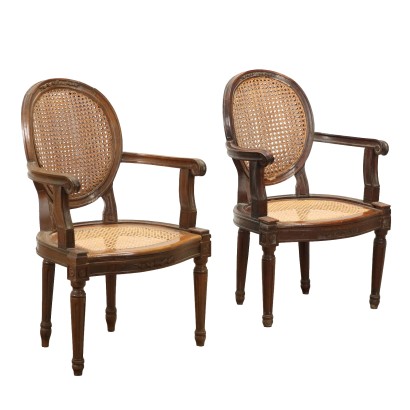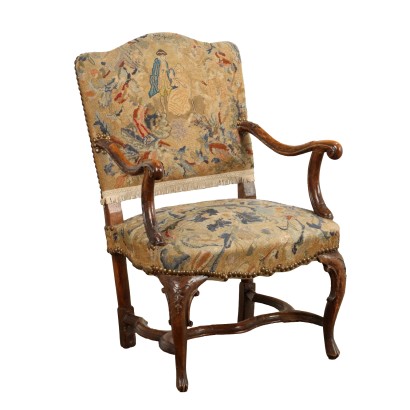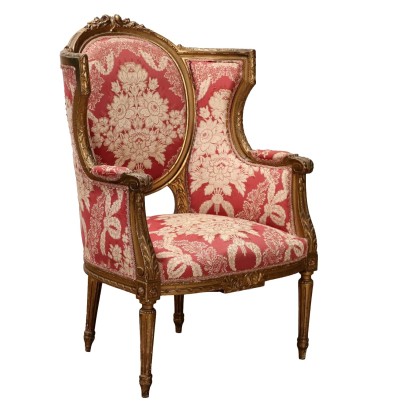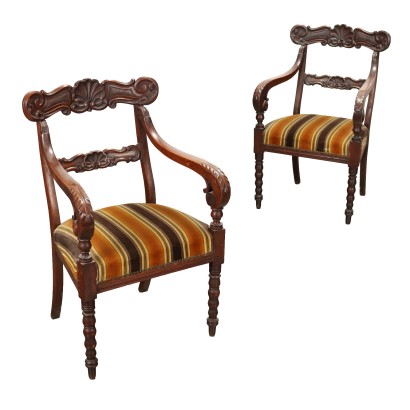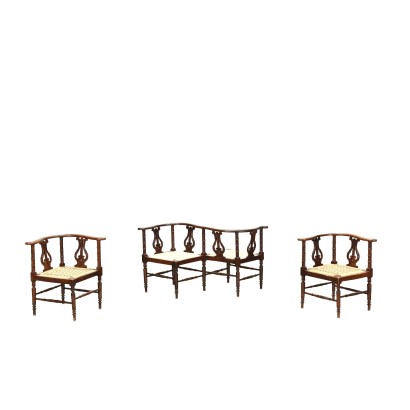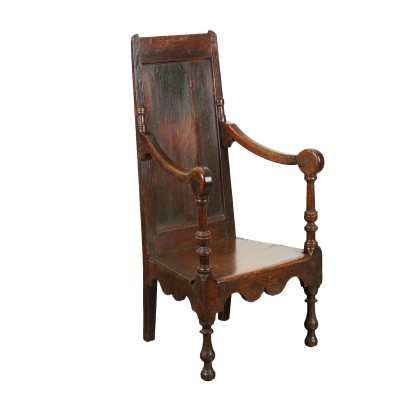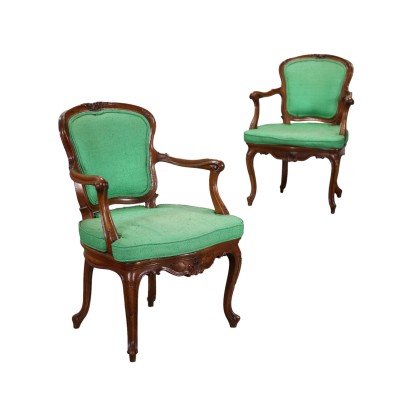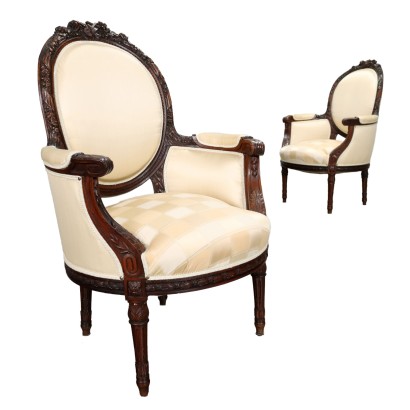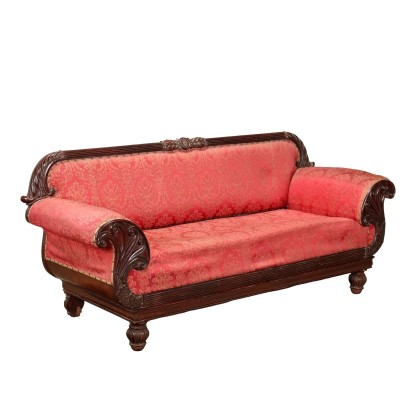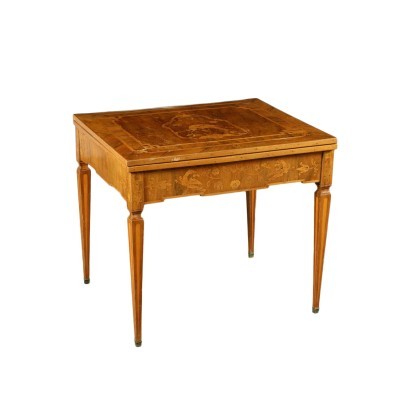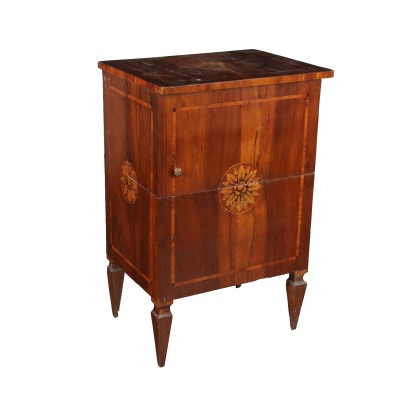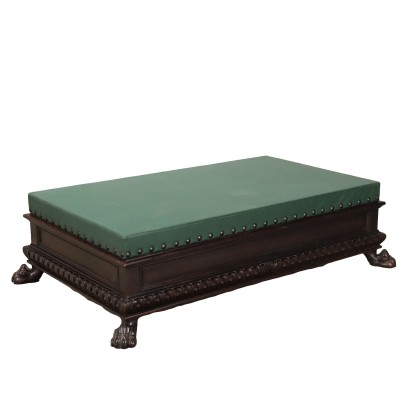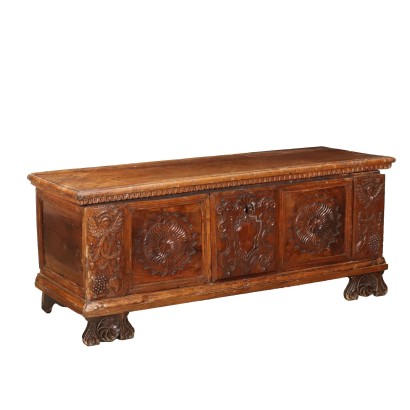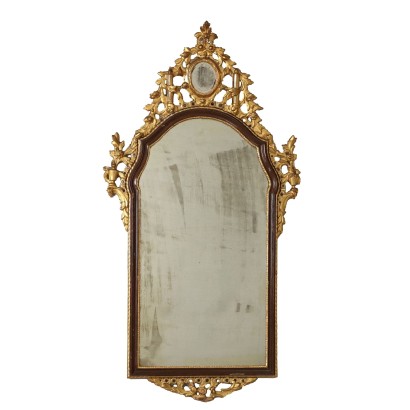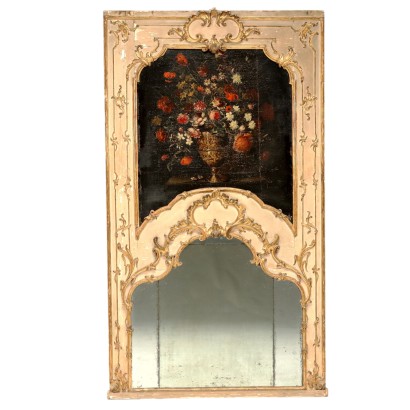Ancient Neoclassical Armchairs '700 Carved Walnut - Piacenza, Last Fourth of the XVIII Century
Features
Piacenza, Last Fourth of the XVIII Century
Style: Neo-Classical (1765-1790)
Age: 18th Century / 1701 - 1800
Origin: Piacenza, Emilia Romagna, Italy
Main essence: Walnut
Material: Cane , Carved Wood
Description
Pair of walnut armchairs, one neoclassical from Piacenza, the other in style made at the beginning of the twentieth century. Medallion backrests with double caning, armrests ending in a curl; apron decorated with floating elements and ribbon, the latter also present on the top of the backrest. Fluted truncated cone legs ending with pear-shaped feet. Canopy seat.
Product Condition:
Product which due to age and wear requires restoration and re-polishing. We try to present the real state of the furniture as completely as possible with photos. If some details are not clear from the photos, what is stated in the description applies.
Dimensions (cm):
Height: 94
Width: 60
Depth: 59,5
Seat height: 41
Additional Information
Style: Neo-Classical (1765-1790)
This historical period includes a first phase that can be properly defined as the Louis XVI style.nOnly at a later time, with the maturation of archaeological fashions, was a new vision of furnishing civilization formulated and codified, now fully attributable to the Neoclassical Style.
In fact, both trends coexisted in unison until the last years of the eighteenth century.
nIn the field of cabinet making, the Directoire, Retour d'Egypte, Consular and Empire styles also fall within the neoclassical era.
nFind out more about Neoclassicism with the insights from our blog...
n
Age: 18th Century / 1701 - 1800
18th Century / 1701 - 1800Main essence: Walnut
Walnut wood comes from the plant whose botanical name is juglans regia , probably originally from the East but very common in Europe. Light or dark brown in color, it is a hard wood with a beautiful grain, widely used in antique furniture. It was the main essence in Italy throughout the Renaissance and later had a good diffusion in Europe, especially in England, until the advent of mahogany. It was used for solid wood furniture and sometimes carvings and inlays, its only big limitation is that it suffers a lot from woodworm. In France it was widely used more than anything else in the provinces. In the second half of the eighteenth century its use decreased significantly because mahogany and other exotic woods were preferred.Material:
Cane
Carved Wood
Other customers have searched:
Poltrona, seggiolone, trono, poltrona antica, poltrona da ufficio, bergère ..
Dai un'occhiata anche ai nostri approfondimenti sul blog e alle presentazioni di FineArt:
Leggi di più
La poltrona Bergère: trasformazioni di un intramontabile classico
Dici relax e pensi poltrona
Breve storia della sedia, dall'Antico Egitto alla produzione in serie
Seggiolone, Roma XVII secolo
E dai un'occhiata anche alle poltrone tra gli arredi di design
Poltrone Delfino, Erberto Carboni per Arflex
Poltrona 'Fiorenza', Franco Albini per Arflex
Poltrona Regent, Marco Zanuso per Arflex
Poltrone Delfino, Erberto Carboni per Arflex
Poltrona '806' Carlo De Carli per Cassina
Sull'antiquariato in generale dai un'occhiata anche a:
Classic Monday: da un pezzo dei nostri magazzini alla storia dell'antiquariato
L'antiquariato dalla A alla Z: il Dizionario dell'Antiquariato
Il dizionario dell'antiquariato - Lastronatura
Il dizionario dell'antiquariato - Mascherone
Il dizionario dell'antiquariato - Natura morta
Il dizionario dell'antiquariato - Opificio
Il dizionario dell'antiquariato - Pastiglia
Il dizionario dell'antiquariato - Savonarola
Il dizionario dell'antiquariato - Rosone
Leggi di più
La poltrona Bergère: trasformazioni di un intramontabile classicoDici relax e pensi poltrona
Breve storia della sedia, dall'Antico Egitto alla produzione in serie
Seggiolone, Roma XVII secolo
E dai un'occhiata anche alle poltrone tra gli arredi di design
Poltrone Delfino, Erberto Carboni per Arflex
Poltrona 'Fiorenza', Franco Albini per Arflex
Poltrona Regent, Marco Zanuso per Arflex
Poltrone Delfino, Erberto Carboni per Arflex
Poltrona '806' Carlo De Carli per Cassina
Sull'antiquariato in generale dai un'occhiata anche a:
Classic Monday: da un pezzo dei nostri magazzini alla storia dell'antiquariato
L'antiquariato dalla A alla Z: il Dizionario dell'Antiquariato
Il dizionario dell'antiquariato - Lastronatura
Il dizionario dell'antiquariato - Mascherone
Il dizionario dell'antiquariato - Natura morta
Il dizionario dell'antiquariato - Opificio
Il dizionario dell'antiquariato - Pastiglia
Il dizionario dell'antiquariato - Savonarola
Il dizionario dell'antiquariato - Rosone
Product availability
The product can be seen at Cambiago
Immediate availability
Ready for delivery within 2 working days from ordering the product.



